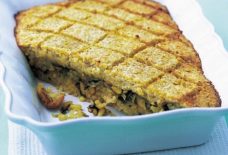Jamaa el Fna – Marrakesh’s Kaleidoscope of Entertainment
Jamaa el FnaBY: Habeeb Salloum/Contributing writer
What has made Marrakesh, the southern capital of Morocco, a true tourist mecca is Jamaa el Fna, one of the most famous and liveliest entertainment spots on earth. A world unto itself, this bustling square, which gives the city its character, is a chaotic outdoor circus which can hold up to 10,000 people. It is the largest and most written about entertainment-trading spot in Morocco. For centuries, it has been the square in Marrakech where people have come to eat, trade and be healed or entertained.
Here, affluent camera-carrying tourists rub shoulders with colourfully dressed Berber men and women from the High Atlas Mountains, intermixed with other Moroccans attired in a spectrum of costumes – from the traditional to the very modern. Day in and day out, from sunrise when Jamaa el Fna comes to life to long after sunset, this picturesque scene intensifies until it reaches its climax at about 9 P.M.
During the day, the square is dominated by carts and stalls selling freshly squeezed orange juice, dried fruits, spices and nuts. As the day fades into the evening the square’s activity increases and it becomes crowded. Now, the aroma of grilled meats fill the air as people flock in droves to the newly setup food stalls to feast on barbecued kababs, fish and other traditional Moroccan foods. Sated, visitors and locals move through the square, and watch the activity unfold around them.
Originally, in the Middle Ages, Jamaa el Fna was not a tourist attraction, but only a trading souk, like the numerous others in Morocco. Some historians believe that it was once a place where the ruling sultan hung the heads of his enemies, hence, its name ‘Assembly of the Dead’. However, it is more likely that the real translation of the name, Jamaa el Fna, is ‘The Mosque that has vanished’.
Visitors cannot really know or feel Jamaa el Fna unless they stroll in it for at least a few hours, stopping here and there to sample its offerings. The best time to do this is late Sunday afternoon when the massive crowds make the walk hectic but much more memorable.
Orange juice stand in Jamaa el FnaIn the past, the dense mass of humanity led to garbage and dirt, which has now been virtually eliminated. City officials responsible for cleanliness and price regulation now regularly inspect the food offered in the square. Only the noise of packed human beings destroys somewhat the square’s romantic aura.
There are now only a few beggars and pestering young men who offer to guide or take one to the cheapest shop in town now work the square. Real criminal activity is rare. A tourist need not fear the immense gathering of people.
A first-time visitors to the square, should begin by having a tea or coffee on the terrace of Café Argana, overlooking Jamaa el Fna. From here, one has an unobstructed view of the square and its entertainment activities. For many, the panoramic picture of the happenings below is, without doubt, the least expensive diversion in the city.
Down from the café are the food stalls with their mouth-watering aromas. Visitors can try fish, kabab, sausages, fried vegetables and other Moroccan foods served with loaves of freshly baked bread. The price is right – in fact- very cheap. A meal costs around $5., but one must bargain.
After feasting on the tasty food visitors will be set to explore the square with its endless activities. The choices of what to see and do are never-ending. Youth from Mauritania performing breathless acrobatic feats; primitive dentists with tables of extracted teeth; herbalists with their bizarre concoctions; ancient men emotionally spinning tales from the Arabian Nights; magicians doing their tricks; monkey trainers featuring their trained animals; fortune tellers plying their trade; folkloric dancers and musicians doing their best to attract the crowds; old ladies ready to henna, or tattoo willing customers; snake charmers winding reptiles around their necks; mystics preaching about the horror of hellfire; and vendors offering a variety of articles, from handmade goods, dyes and perfumes to all types of clothing are some of the daily events taking place on the square.
Moroccan water seller in traditional dress Jamaa el Fna square market place in Marrakesh’s Medina quarter Morocco.
Gaudily red-clad water sellers wearing broad-rimmed hats attract the attention of many visitors. Carrying goatskins full of water, while jingling a necklace of brass cups dangling from their necks, they seem to be ancient figures from the past. Tourists gladly the 50 cents asked for taking their photos.
All a traveller needs is a pocketful of small change for when, after a performance, the hat is passed around. The cost is minimal. One can spend half a day on the square, seeing dozens of performers and it would only cost from around $5. to $10.
When strollers tire of walking, they can rest awhile atop the edging Café Glacier and for 1 Euro sip on a tea or juice and watch the activities in the square below. From this high point, there is a full view of Jamaa el Fna and its activity. The world of colour below soon makes visitors forget their fatigue and, after the hours of meandering, food usually comes to mind.
A few buildings away the Marrakchi restaurant offers the best of Moroccan fare. To dine in this fine eating-place would be a perfect finale to an event-filled afternoon. As visitors enjoy their bastilla, couscous or tajine, surrounded by Andalusian-Moorish decor, they can relax and watch darkness envelop the exotic world they have just explored.









